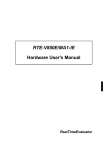Download User`s Manual (Rev.1.03)
Transcript
KIT-V850E/MA3-IE User's Manual (Rev.1.03) RealTimeEvaluator KIT-V850E/MA3-IE User’s Manual (Rev.1.02) Software Version Up * The latest RTE for Win32 (Rte4win32) can be down-loaded from following URL. http://www.midas.co.jp/products/download/english/program/rte4win_32.htm Notice * The copyright associated with KIT-V850E/MA3-IE (including software and manual) are proprietary to Midas Lab. Co., Ltd. * This software and manual are protected under applicable copyright laws, and may not be copied, redistributed, or modified in whole or in part, in any way without explicit prior written permission from Midas Lab. Co., Ltd. * While this product was manufactured with all possible care, Midas Lab. Co., Ltd. does not guarantee that this product is free from any problem. * Midas Lab. Co., Ltd. and its distributor assume no responsibility whatsoever for any result of using this product. * The contents and specifications of this software and this manual are subject to change without notice. Trademarks * MS-Windows, Windows, MS, and MS-DOS are the trademarks of Microsoft Corporation, U.S.A. * The names of the programs, systems, CPUs, and other products that appear in this document are usually trademarks of the manufacturer of the corresponding product. 1 KIT-V850E/MA3-IE User’s Manual (Rev.1.02) REVISION HISTORY Rev.1.00 Jan. 8, 2003 1st edition Rev.1.01 Feb. 8, 2003 The following modification and addition are made: * The explanation of SW1 is modified. * A description related to the setting of the ASID register is added to "Precautions". Rev.1.02 Mar. 12, 2003 Clerical error correction Rev.1.03 Apr. 25, 2003 Clerical error correction The notation of SW3 and SW4 is reverse at Chapter.4. 2 KIT-V850E/MA3-IE User’s Manual (Rev.1.02) CONTENTS 1. OVERVIEW.............................................................................................................................................. 4 2. HARDWARE SPECIFICATIONS ............................................................................................................. 5 3. INSTALLATION PROCEDURE ............................................................................................................... 7 4. SETTING SWITCHES.............................................................................................................................. 8 5. CONNECTING THIS PRODUCT TO THE USER SYSTEM .................................................................... 9 Mounting the EV socket........................................................................................................................... 9 Turning the power on............................................................................................................................... 9 Turning the power off............................................................................................................................... 9 6. RTE for WIN32 ...................................................................................................................................... 10 Invoking ChkRTE2.exe .......................................................................................................................... 10 7. PRECAUTIONS ..................................................................................................................................... 12 Restrictions on CPU emulation.............................................................................................................. 12 Precautions for connecting the user system.......................................................................................... 12 Handling the pod ................................................................................................................................... 12 Settings required for using external bus emulation memory ................................................................. 12 Initializing the ASID register .................................................................................................................. 13 Adjusting supports ................................................................................................................................. 13 External clock input ............................................................................................................................... 13 Caution related to the delay time........................................................................................................... 13 HALT instruction .................................................................................................................................... 13 Breakpoints............................................................................................................................................ 13 Measuring the execution time................................................................................................................ 13 Mounting the CPU on the EV socket ..................................................................................................... 14 Other information................................................................................................................................... 14 APPENDIX A. PACKAGE DRAWING OF THE POD SECTION ............................................................... 15 APPENDIX B. USER INTERFACE CIRCUITS .......................................................................................... 16 APPENDIX C. DETAILS OF TRACE FUNCTIONS ................................................................................... 19 Overview of the trace function ............................................................................................................... 19 Delay count............................................................................................................................................ 20 Trace execution mode ........................................................................................................................... 20 Sub-switch, section, and qualify ............................................................................................................ 21 Starting trace ......................................................................................................................................... 21 Trigger condition.................................................................................................................................... 22 Stopping trace ....................................................................................................................................... 23 Terminating trace................................................................................................................................... 23 Forced delay mode................................................................................................................................ 24 3 KIT-V850E/MA3-IE User’s Manual (Rev.1.02) 1. OVERVIEW KIT-V850E/MA3-IE is a kit that performs in-circuit emulation for NEC RISC microprocessor V850E/MA3. Using a dedicated emulator chip in the kit has made it highly transparent, compact, and lightweight. Connect the pod to the RTE-2000-TP and use it. Two types of debug monitors are available: Dedicated PARTNER and GHS Multi. This product comes with the following items: 1. V850E/MA3 pod : 1 2. RTE for Win32 setup disk : 1 3. User's Manual : 1 4. Power supply (RTE-PS04: +5 V/4.5 A) : 1 5. EV socket : 1 set 6. Support spacers and screws : 1 set In addition to the above items, the following items are required for using this product. They are not standard accessories. 7. RTE-2000-TP-x-x 8. Interface kit (interface card and cable set) One of the following kits is required: • PC card interface kit • PC98 desktop PC interface kit • DOS/V desktop PC interface kit • PCI bus interface kit 9. Debugger Either of the following debuggers is required: • Multi debugger : Multi and Midas server • PARTNER debugger : PT-V850E1-IE/TP 4 KIT-V850E/MA3-IE User’s Manual (Rev.1.02) 2. HARDWARE SPECIFICATIONS Emulation Target device V850E/MA3 (TQFP-144) RTE-TP format to be used RTE-2000-TP Emulation functions Operating frequency Clock source Main clock *4 80 MHz (max.) Automatic switching between external and internal clocks (internal: 8 MHz) Internal ROM emulation capacity 1 MB Internal RAM emulation capacity 60K bytes (can be switched among 4K, 12K, 28K, and 60K bytes) External memory emulation capacity Operation voltage 4M bytes (mounted in the pod section as standard) 3.3 V Event function Number of events Setting of execution address 8 Setting of data access 6 Address specification Maskable Data specification Maskable Status specification Maskable Number of sequential unit stages Path counter 4 12 bits Break functions Hardware breakpoints Instruction/access breakpoints 2 Address specification Maskable Data specification Maskable Status specification Maskable Software breakpoints 100 Breaks that can be set using events Supported Step breaks Supported Manual breaks Supported External breaks (High/Low edge) Supported Trace functions Trace data bus 48 bits Trace memory 48 bits × 256k words Trigger setting Trigger that can be set using an execution address Supported Trigger setting by data access Supported Trigger setting by event Supported Trigger setting by external input Supported Start/stop specification (sub-switch) Supported Trace delay 0 - 3FFFF Trace clock Time tag 80 MHz 100 ns - 30 h Disassembled trace data display function Provided Complete trace mode specification function (no real time) Provided 5 KIT-V850E/MA3-IE User’s Manual (Rev.1.02) ROM emulation functions (*5) Map function in block (USER/EMEM) 64k words Used as RAM Supported Memory capacity 8M - 128M bytes Access time ((): burst cycle) 35 ns (30 ns) (*1) Operation voltage 1.8 - 5 V (*2) Electrical condition LV-TTL, 5-V tolerant (*3) Number of ROMs that can be emulated DIP-32pin-ROM (8-bit ROM) 4 (max.) DIP-40/42pin-ROM (16-bit ROM) 4 (max.) Extend STD-16BIT-ROM connector 4 (max.) Sizes of ROMs that can be emulated (bits) DIP-32-ROM (8-bit bus) 1M, 2M, 4M, 8M (27C010/020/040/080) DIP-40-ROM (16-bit bus) 1M, 2M, 4M (27C1024/2048/4096) DIP-42-ROM (16-bit bus) *4 Extend STD-16BIT-ROM (16-bit bus) 8M, 16M (27C8000/16000) 1M, 2M, 4M, 8M, 16M, 32M, 64M, 128M, 256M (32M bytes) Bus width specification (bits) Pin mask functions 8/16/32 NMI, INTWDG, WAIT-, HLDRQ, RESET- *1, 2, 3: Values when RTE-2000-TP + CBL-STD16-2K is used. *2: Note that the DC characteristics of each cable may not electrically match when the supply voltage is 2.3 V or less. *4: External memory emulation (capacity: 4M bytes) occupies one of /CS[0..7] signals and supports a 16-bit bus only. *5: The user system must have a ROM socket or dedicated connector for connecting the ROM emulation cable. For details, refer to the manual of the RTE-2000-TP main unit. Up to four E.MEM boards can be mounted on the RTE-2000-TP, and the maximum capacity is 128M bytes. 6 KIT-V850E/MA3-IE User’s Manual (Rev.1.02) 3. INSTALLATION PROCEDURE Install this product using the following procedure: 1. Installing the RTE-2000-TP → Refer to the manual of the RTE-2000-TP. 2. Connecting this product to the RTE-2000-TP → Connect the pod cable to the CPU-IF connector on the JTAG/N-Wire board module of the RTE-2000-TP. 3. Setting switches on the pod → See Chapter 4 in this manual. 4. Connecting this product to a user system → See Chapter 5 in this manual. 5. Installing RTE for Win32 → Refer to the manual of RTE for Win32. 6. Initializing RTE for Win32 → See Chapter 6 in this manual. 7. Installing the debugger → Refer to the manual of the target debugger. 7 KIT-V850E/MA3-IE User’s Manual (Rev.1.02) 4. SETTING SWITCHES SW1 Switch for setting the emulation mode SW1 Symbol 1 CKSEL Function 2 PSEL 3 SVMODE 4 INTSEL Initial value Specifies the status of the CKSEL pin on the CPU when the internal clock is used. OFF: High level (through mode), ON: Low level (PLL mode) ON Specifies the status of the PSEL pin on the CPU when the internal clock is used. OFF: High level, ON: Low level OFF Use this switch in the factory-set status. ON Specifies the switch mode for the clock supplied to the CPU. OFF: Auto, ON: Internal clock OFF [INTSEL] Switches the clock supplied to the CPU and related signals (CKSEL and PSEL). OFF : When the user system is connected, the signal from the user system is connected. Otherwise, the internal clock is used. ON : The internal clock is always used. The internal clock frequency is 8 MHz, CKSEL enters the status set by SW1-1, and PSEL enters the status set by SW1-2. SW2 Use this switch with all contacts set to OFF because it is not used for this product. SW3 and SW4 Switches for setting external bus emulation memory. External bus emulation memory occupies one of eight CS- signals of the V850E/MA3 to map the RAM mounted in the pod as a hardware component. Set these switches as follows. SW4 SW3 CS into which E.MEM is to be mapped 1 2 3 4 5 6 7 8 1 2 3 4 CS0- OFF ON ON ON ON ON ON ON OFF OFF OFF ON CS1- ON OFF ON ON ON ON ON ON ON OFF OFF ON CS2- ON ON OFF ON ON ON ON ON OFF ON OFF ON CS3- ON ON ON OFF ON ON ON ON ON ON OFF ON CS4- ON ON ON ON OFF ON ON ON OFF OFF ON ON CS5- ON ON ON ON ON OFF ON ON ON OFF ON ON CS6- ON ON ON ON ON ON OFF ON OFF ON ON ON CS7- ON ON ON ON ON ON ON OFF ON ON ON ON Not used ON ON ON ON ON ON ON ON x x x OFF SW1 and SW2 are on the top of the middle board near the end of the pod. SW3 and SW4 are on the back of the pod. Do not change the setting of SW0, an eight-contact switch, on the top of the middle board. 8 KIT-V850E/MA3-IE User’s Manual (Rev.1.02) 5. CONNECTING THIS PRODUCT TO THE USER SYSTEM Connect this product to the user system using the following procedure. Mounting the EV socket Solder the EV socket supplied with the product on the user system. Turning the power on 1. Turn the power to the host personal computer on. 2. Turn the power to the RTE-2000-TP on. 3. Turn the power to the V850E/MA3 pod on. (Connect the dedicated power supply to the power supply jack.) Confirm that the LED indicating the power status of the pod comes on. 4. Turn the power to the user system on. Confirm that the LED indicating the power status of the user system comes on. 5. Start up the debug monitor. Turning the power off 1. Exit the debug monitor. 2. Turn the power to the user system off. Confirm that the LED indicating the power status of the user system goes out. 3. Turn the power to KIT-V850E/MA3-IE off. (Disconnect the dedicated power supply from the power supply jack.) 4. Turn the power to the RTE-2000-TP off. 5. Turn the power to the host personal computer off. [Caution] When soldering the EV socket on the board, be careful about the position of pin 1 because the orientation of the socket is determined. Use the t mark. The following figure shows how the V850E/xxx pod is connected to the user system. V850E/xxx pod To the RTE-2000-TP Two LEDs Near LED: Power status of the pod Far LED : Power status of the user system Power supply jack Support 703134GJ144-EA EV socket Soldering 703134GJ144-TC User system 9 KIT-V850E/MA3-IE User’s Manual (Rev.1.02) 6. RTE for WIN32 This chapter describes the setting of RTE for WIN32. Invoking ChkRTE2.exe After finishing to connect to the user system and apply the power supply for all equipments, invoke ChkRTE2.exe to set up the configuration of "RTE for WIN32". Please set up the "RTE for WIN32" configuration at least one time for newly installed hardware. <Setting up RTE-products> <Selecting RTE> From Product List, select the V850E/MA3-IE located beneath the IE tree. <Selecting I/F-1, I/F-2> Select and specify the host interface that suitable for your system from pull-down menu. (The display in example shows that PCI-Card is assigned.) V850E/MA3-IE is supported by rte4win32 ver.5.09 or later. 10 KIT-V850E/MA3-IE User’s Manual (Rev.1.02) <Function test> For the function test, RTE for WIN32 must properly be connected to the user system and capable of debugging. If you set up RTE and then perform a function test according to the screen instructions, the following dialog box appears upon the normal completion of the test. In this state, control from the debugger is possible. Perform the ChkRTE2.exe function test when the power to the user system is on if it is connected. If the power is off, an error occurs. 11 KIT-V850E/MA3-IE User’s Manual (Rev.1.02) 7. PRECAUTIONS This chapter provides the precautions you should observe when using KIT-V850E/MA3-IE. Restrictions on CPU emulation Bit[0,1] of port CT cannot be used as [LBE-,UBE-]. Precautions for connecting the user system 1) If the power to the user system is turned off in the break status, the ICE puts the CPU into the forced reset status and stops the output of the signal line to the user system. In this status, the user system cannot be controlled from the debugger. If you want to turn the power to the user system again, it is desirable to restart up this system from scratch in principle. To continue with debugging from necessity, turn the power to the user system on again and be sure to issue the initialize (init) command from the debugger. Then, set the CPU and debugger again. If the power to the target system is turned off, then on again after the debugger has started up, however, the debugger may hang up. In this case, restart up the system from scratch. Do not leave the RTE system with only the power to the user system turned off because this status may cause a failure in the user system or this product. 2) If the CPU in the user system fails to operate normally, the debugger may also fail to start up or hang up with specific commands. Handling the pod The entire circuit of the pod is exposed. Do not allow the circuit to come into contact with metals and others when it is energized. Otherwise, a failure may occur in the main unit. Settings required for using external bus emulation memory The following settings are required: Port settings: Port AL : Set this port as addresses in the separate mode. Port AH : Set A16 to A21 as addresses. Port DL : Set this port as a data bus. Port CS : Set CS- for mapping emulation memory to enabled. Port CT : Set either combination, LWR-/UWR or LBE-/UBE/WR-, to enabled. (The memory cannot be used with the latter combination currently, however.) Set RD- to enabled. Set ASTB to enabled in the multiplex mode. MEMC settings (setting for the CS- space for mapping emulation memory) BCTx : MEn = 1, MMn = Any, BTn[1,0] = [0,0] DWCx : When the bus clock frequency is less than 33 MHz : One wait state When the bus clock frequency is 33 MHz or more : Two wait states LBS : Set LB0x = 1 (16-bit bus). 12 KIT-V850E/MA3-IE User’s Manual (Rev.1.02) Be sure to set port AH so that addresses from A16 to A21 are enabled. Port AH is directly connected to emulation memory as addresses. If part of addresses are set as a port, the emulation memory cannot be accessed correctly. A user system should not drive a data bus in the state with all inactive CS signals. It becomes the following causes when driving. * Injustice of access to an emulation memory * Failure of a user system or ICE Initializing the ASID register Before using the emulator, set the value of the ASID register to 0x00 for future compatibility. If the emulator is used with the ASID register set to other than 0x00, a break function may be disabled. Adjusting supports The pod is designed so that supports can be mounted at its end. Adjust the supports so that the pod becomes parallel to the board on the user system when it is connected to the user system with the EV socket. To adjust the height of a support, loosen the nut and slide the screw in or out. After adjusting the height, tighten the nut to fix the screw position. External clock input When an external clock is supplied, there are the following restrictions: * When the clock is input from an oscillator: Use the clock at frequencies from 5 to 25 MHz. * When a crystal or another resonator is connected: Use the clock at frequencies from 4 to 8 MHz. The constant of the external capacitor must be adjusted according to the resonator individually. Caution related to the delay time Almost all signals are connected directly between the CPU in the pod and the user system. However, a delay of about 3 ns (typical) may occur due to the wiring length to the tip and the capacity, compared with direct CPU connection. Design the user system with accommodating this delay. HALT instruction When a break is made with the HALT instruction, the break address is the starting address of the instruction next to the HALT instruction. Breakpoints If a hardware breakpoint is set to the second instruction of an instruction string that simultaneously execute two instructions, it is invalid. Measuring the execution time The time command displays the execution time from the previous "execution to a break". The measurement value contains the overhead time (error of several CPU clocks). Note the following point: 13 KIT-V850E/MA3-IE User’s Manual (Rev.1.02) → If a breakpoint is set at the execution start address, the measurement error is doubled. To measure the execution time, remove the breakpoint at the execution start address. Mounting the CPU on the EV socket Purchase a 703134GJ144-MA, an optionally available component. The 703134GJ144-MA has a socket for mounting the V850E/MA3 on its top. It can be mounted on the 703134GJ144-TC soldered on the user system. Other information Be sure to refer to the Release Note and other manuals if provided. 14 KIT-V850E/MA3-IE User’s Manual (Rev.1.02) 77 66.04 30 22 77 APPENDIX A. PACKAGE DRAWING OF THE POD SECTION 1pin 13 GJ144-EA 20 43 99 GJ144-TC 22 69 77 22 Unit: mm 15 KIT-V850E/MA3-IE User’s Manual (Rev.1.02) APPENDIX B. USER INTERFACE CIRCUITS Port 0, Port 1, Port 2, Port 3, Port 4, Port 5, Port 8 TVDD3 100 KΩ User system CPU Port AL, Port AH, Port DL, Port CS, Port CT, Port CD, Port BD TVDD3 100 KΩ 22 Ω User system MEMC Port ANI0-ANI7 TVDD3 100 Ω CPU User system 16 KIT-V850E/MA3-IE User’s Manual (Rev.1.02) RESET- TVDD3 FPGA LCX14 100 KΩ User system CPU X1, X2 VHCU04(2/6) 1 MΩ 100 Ω 1 MΩ X1 User system 100 Ω CPU X2 1 MΩ AVDD0, AVDD1, AVSS CPU AVDD AVSS +3.3 V NC. AVDD AVSS User system 17 KIT-V850E/MA3-IE User’s Manual (Rev.1.02) CKSEL, PSEL, VDD3, VDD25, VSS, and others Others Other VDD3 circuits Other VDD25 circuits NC. 1 KΩ To the level sense circuit VDD3 (--pin) 1 KΩ To the level sense circuit CKSEL 100 KΩ User system +3.3 V To the level sense circuit VSS : 10 KΩ PSEL : 100 KΩ VSS (--pin), PSEL Other VSS circuits Remark: TVDD3 is an internal power supply equivalent to a 3.3-V power supply in the user system. 18 KIT-V850E/MA3-IE User’s Manual (Rev.1.02) APPENDIX C. DETAILS OF TRACE FUNCTIONS This appendix describes the real-time trace function. Overview of the trace function The real-time trace function writes the details of the execution (trace data) output from the CPU in the trace buffer in the ICE for each execution. You can check the data using the trace command. You can set the trace mode, trace start condition, trigger condition, section condition, qualify condition, and other conditions to specify the loading of trace data. For the flow of loading trace data, see Figures 1 and 2. Start of trace The trigger condition is satisfied. End of trace CPU execution Data loaded into the ICE CPU Trace Trace data Figure 1 Flow of loading trace data End The trigger condition is satisfied. If the trace buffer in the ICE becomes full, it is overwritten from the beginning. Start of trace Figure 2 Trace data in the ICE 19 KIT-V850E/MA3-IE User’s Manual (Rev.1.02) Delay count The delay count means the number of cycles in which trace data is to be loaded after the trigger condition is satisfied (Figure 3). The number of cycles differs depending on the type of CPU execution. One cycle is not one execution unit. Start of trace The trigger condition is satisfied. End of trace CPU execution Trace data is loaded during the specified number of cycles. Figure 3 Flow of delay count Trace execution mode In the real-time mode, trace data is loaded with priority given to the CPU execution. If the trace buffer (FIFO) in the CPU becomes full, part of trace data may not be loaded (Figure 4). When the trace buffer in the CPU is full CPU execution Loading of trace data The details of execution during this section are lost. Overflow information and not trace data is written in the trace buffer. Figure 4 Real-time mode 20 KIT-V850E/MA3-IE User’s Manual (Rev.1.02) In the non-real-time mode, all trace data can be loaded. If the trace buffer (FIFO) in the CPU becomes full in this mode, the CPU execution is temporarily stopped and is automatically restarted (Figure 5). The CPU is temporarily stopped. The CPU is restarted. CPU execution Loading of trace data Trace data is not loaded when the CPU is temporarily stopped. Figure 5 Non-real-time mode Sub-switch, section, and qualify The sub-switch indicates whether OR or AND (set by tenv [subor|suband]) of the section and qualify conditions are satisfied (on) or not (off). You can specify cycles in which trace data is to be loaded according to the on or off status (sswon/sswoff command). By specifying cycles in which trace data is to be loaded for sswon and nothing to be loaded for sswoff, the on/off status of this sub-switch corresponds to the start or stop of trace. (The initial value of the sswon/sswoff command is as described above. In the description below, these commands are assumed to be set to their initial value.) You can specify a section using the tsp1 and tsp2 commands and evt secon and secoff parameters. Use tsp1 and secon to specify that a section is established (on) and tsp2 and secoff to specify that a section is not established (off). The event condition specified for qualify in the evt command is used as a qualify condition. When the event condition is satisfied, the qualify condition is also satisfied. Starting trace To start loading trace data, the following methods are available: Forced start method (tron force) and the method using the status of the sub-switch according to the section and qualify setting. (Figure 6) To set the loading condition using the sub-switch, use sswon and sswoff. Usually, specify cycles in which trace data is to be loaded for sswon and nothing to be loaded for sswoff. According to this setting, trace data is loaded in the sub-switch on state and the loading of trace data is stopped in the sub-switch off state. 21 KIT-V850E/MA3-IE User’s Manual (Rev.1.02) • Start unconditionally loading trace data (tron force) • Set section point (tsp1, evt secon) • Set qualify (evt qualify) The condition is satisfied. Start of trace CPU execution Loading of trace data Figure 6 Starting trace Trigger condition A trigger condition is used as the start point of delay count (Figure 7). You can set a trigger condition to check the details of the execution before and after the trigger. • The instruction at the trigger address (tp) is executed or trace data (td1, td2, td3, or td4) is accessed. • The external signal condition is as specified (tron noext|posi|nega). • The event match point factor is established (evt match). The condition is satisfied. The trigger condition is satisfied. End of trace CPU execution Execution is traced during as many cycles as the delay count and trace is forcibly terminated. Figure 7 Trigger condition 22 KIT-V850E/MA3-IE User’s Manual (Rev.1.02) Stopping trace To stop loading trace data, use the status of the sub-switch according to the section and qualify setting. (Figure 8) To set the loading condition using the sub-switch, use sswon and sswoff. Usually, specify cycles in which trace data is to be loaded for sswon and nothing to be loaded for sswoff. According to this setting, trace data is loaded in the sub-switch on state and the loading of trace data is stopped in the sub-switch off state. • Set section point (tsp2, evt secoff) • Set qualify (evt qualify) The condition is satisfied. Stop of trace Start of trace Stop of trace CPU execution Loading of trace data Loading of trace data Figure 8 Stopping trace Terminating trace After trace is terminated, no more trace data is loaded. When the end condition is satisfied, unlike the stop condition, trace is not restarted (Figure 9). • Stop CPU execution. • Forcibly terminate trace (troff). • End delay count. The condition is satisfied. Start of trace End of trace CPU execution No more data is loaded. Loading of trace data Figure 9 Terminating trace 23 KIT-V850E/MA3-IE User’s Manual (Rev.1.02) Forced delay mode In the forced delay mode, trace is forcibly terminated when trace data is loaded during the specified delay count (number of cycles) after the start of trace. In this mode, the trigger condition is ignored (Figure 10). When CPU execution starts, trace is started in this mode. Start of trace End of trace CPU execution Trace terminates after trace data is loaded during as many cycles as the delay count. Figure 10 Forced delay mode 24










































